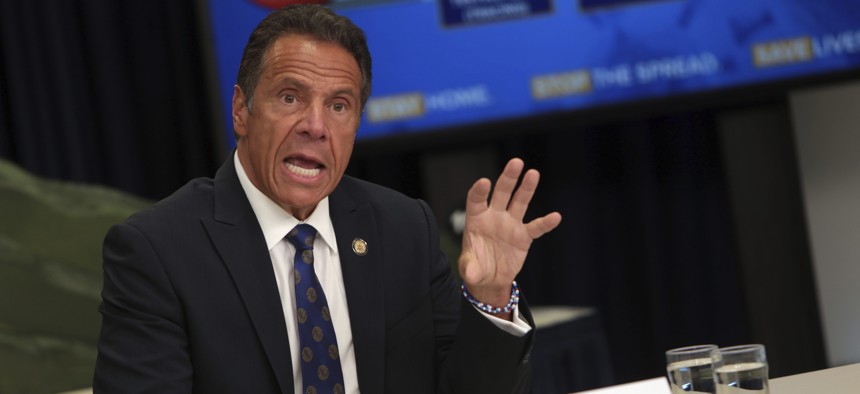Cuomo, Union Leaders Call on Congress to Provide New York $59 Billion in Aid

New York State Governor Andrew Cuomo speaks during a press conference in July. mpi43/MediaPunch /IPX

Connecting state and local government leaders
They say the state and its local governments are in an “impossible financial situation” because of the financial fallout from the coronavirus pandemic.
New York Gov. Andrew Cuomo and labor union leaders on Monday sent a letter to the state’s congressional delegation saying that the state and its local governments require a combined $59 billion in federal aid to deal with budget shortfalls brought on by the coronavirus.
The state “is in an impossible financial situation,” the letter says. “There is no combination of state efforts that will address this financial crisis without federal assistance,” it adds. “Even if state and local governments cut expenses, increase taxes, and reduced services, the revenue shortfall would still be in the billions of dollars.” The letter says the state government alone requires $30 billion in the current fiscal year and the next one to avoid “massive disruption.”
New York City needs another $9 billion, Cuomo and the union leaders say in the letter, and local governments outside of the city need $4.5 billion. They also call for $12 billion in aid for the Metropolitan Transportation Authority, which operates transit and rail services in the New York City region, and $3 billion for the Port Authority of New York and New Jersey.
“I don't care how much you increase taxes to, you couldn't make up that deficit,” Cuomo, a Democrat, said Monday. “I don't care how many savings you find, you couldn't make up that deficit. I don't care how many efficiencies you find, you couldn't make up that deficit.”
Cuomo has warned since the pandemic hit that without additional federal aid the state might need to reduce funding for hospitals, schools and local governments by 20%. Last week POLITICO reported that some local governments in the state have begun cutting staff and programs amid budget pressures and the uncertainty over federal aid.
Leaders of unions that represent health care employees, transportation workers and teachers were among the nine labor leaders who signed the letter. They include George Gresham, president of 1199 SEIU United Healthcare Workers East, which says it is the nation's largest health care union; John Samuelsen, president of the Transport Workers Union International; and Michael Mulgrew, president of the United Federation of Teachers, which says it represents nearly 200,000 educators and other workers.
Negotiations over another coronavirus relief package have largely stalled on Capitol Hill. To what extent the federal government should provide additional state and local aid is a major hangup. Democrats in the House have passed a bill that would provide about $900 billion to state and local governments. Republicans haven’t supported that plan.
Heading into 2020—before the virus hit—New York faced a roughly $6 billion budget deficit, which emerged on Cuomo’s watch. Costs for Medicaid, the federal-state program that provides health care coverage to low-income people, were a big contributor to the budget gap.
U.S. Treasury Department figures show that New York received $7.5 billion from a $139 billion fund meant to assist states and larger-sized localities that Congress created under a coronavirus relief law approved in March. About $5.1 billion of the funding that flowed to New York went to the state and the rest went directly to localities.
Many state and local officials across the country say that while the aid the earlier legislation provided was helpful, it wasn’t enough to deal with the crash in tax revenues and unplanned costs the virus has caused, and that restrictions on how it could be spent were too rigid.
New York isn’t the only place facing budget woes.
Wyoming Gov. Mark Gordon, a Republican, last week finalized a round of state budget cuts totaling more than $250 million, and chopped an additional $80 million for the maintenance of state buildings and university and community college facilities. Under the plan, the state’s Department of Health will see a 9%, or roughly $90 million, cut.
Meanwhile, In Chicago, a city long known for its financial troubles, Mayor Lori Lightfoot and other officials on Monday released a fiscal 2021 budget forecast that projects a $1.2 billion gap, the largest in the city’s history. Lightfoot’s office said the shortfall is largely attributable to financial fallout from the pandemic.
Bill Lucia is a senior reporter for Route Fifty and is based in Olympia, Washington.

NEXT STORY: Fight Against Fraud Slows Payments to Unemployed





